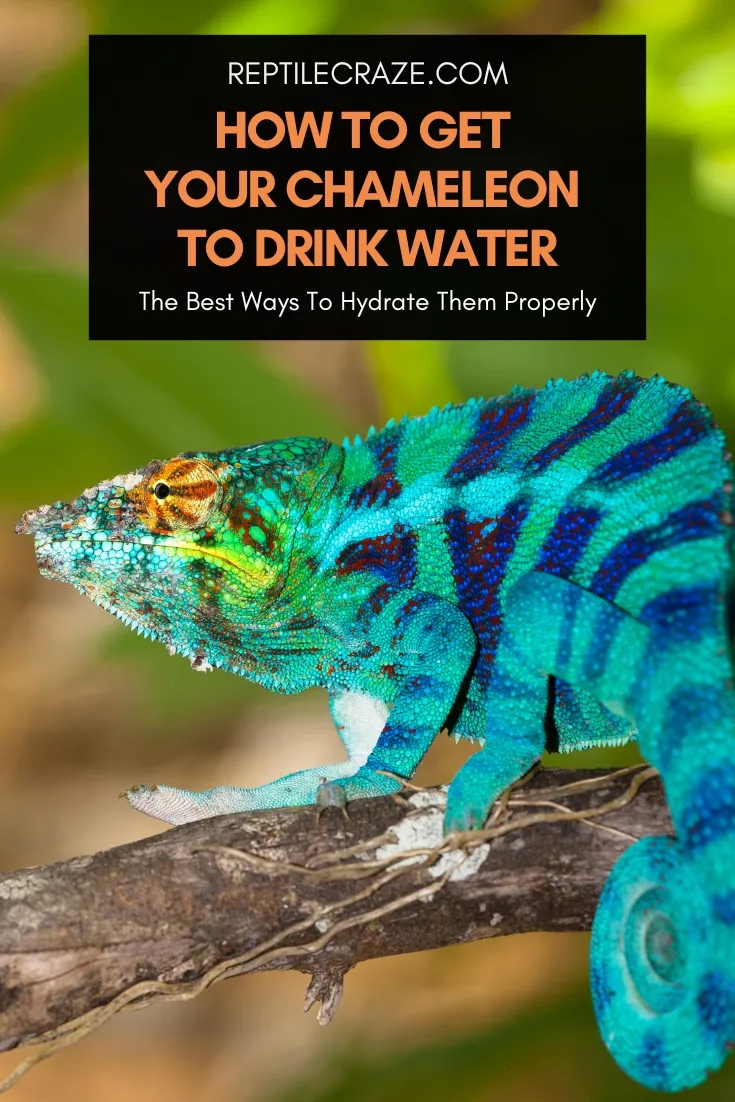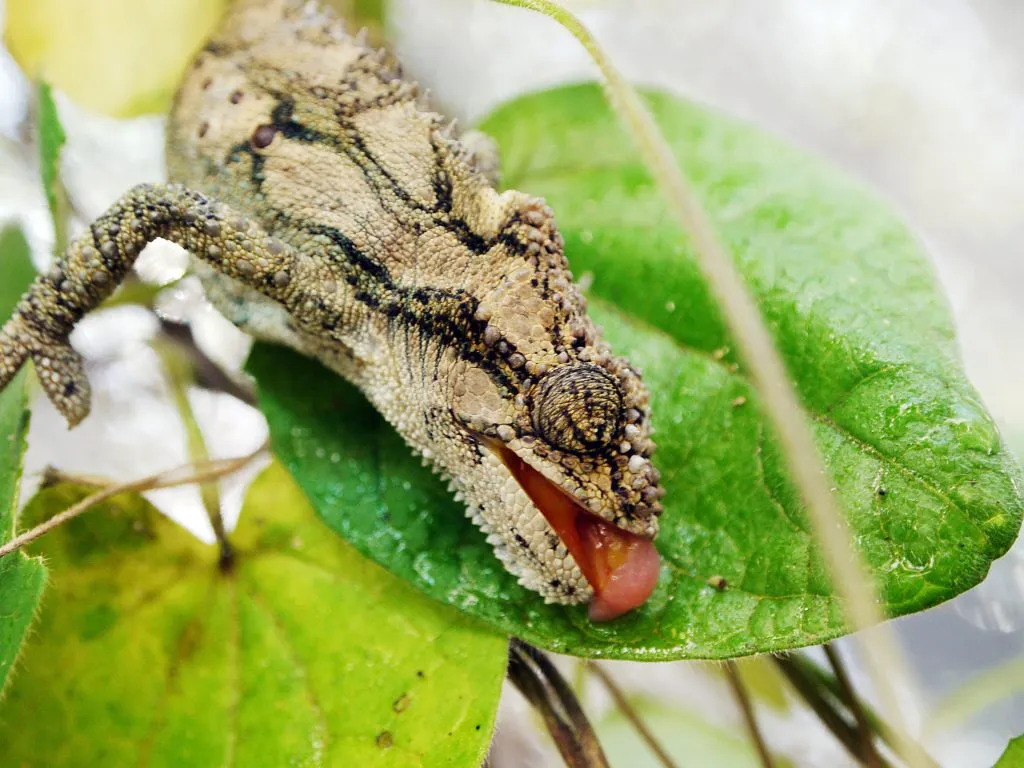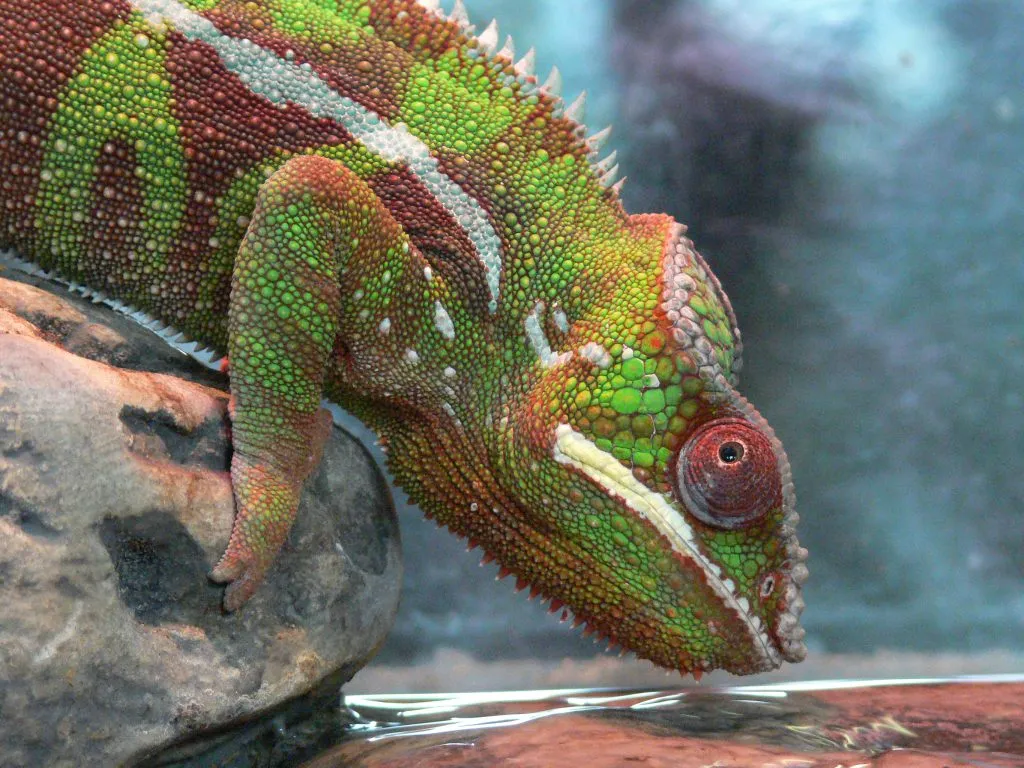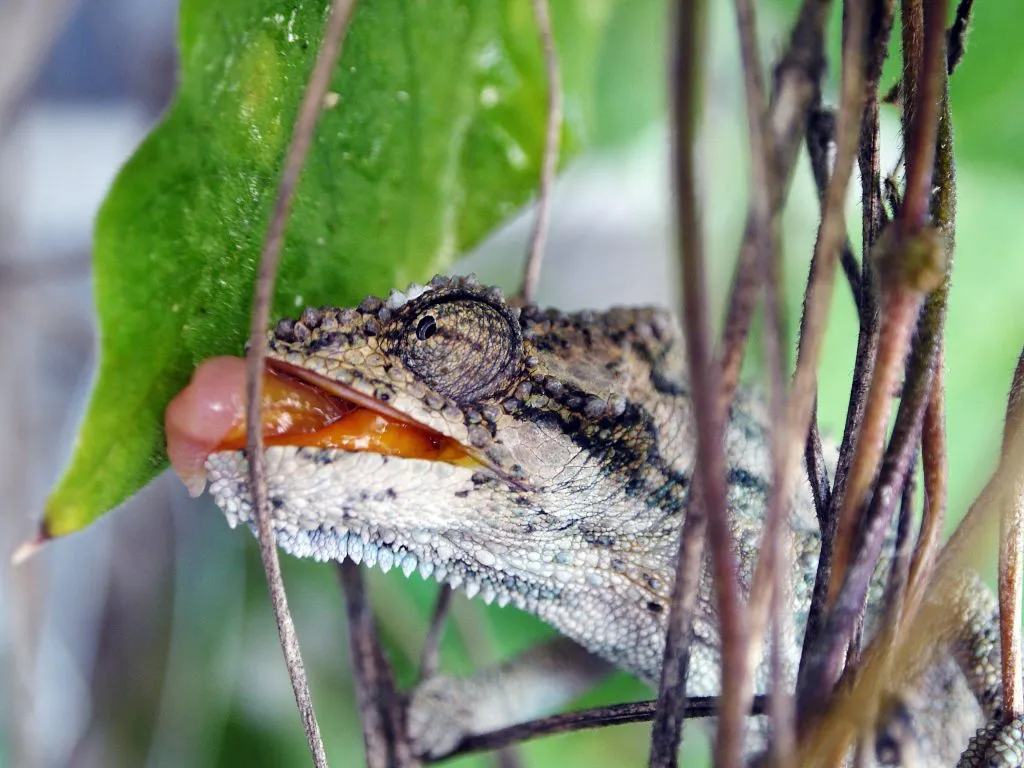
Chameleons are known to be picky about where they drink water. Knowing how to get a chameleon to drink is a real challenge. Keepers who do not know enough about how a chameleon hydrates itself often risk their pet becoming fatally dehydrated.
In the wild, chameleons “drink water” or get moisture from water droplets on leaves, fog, dew, and
Chameleons are highly delicate creatures that need specialized care and attention, especially regarding hydration. This article will discuss helpful hydration strategies to get your chameleon to drink water and stay healthy and hydrated.
Table of Contents
The Best Way To Hydrate A Chameleon
Wild chameleons get hydrated from 4 primary moisture sources. These are:
- Fog – This is the dominant source of water and includes clouds, mist, and vapor.
- Rain – Chameleons hide from the rain but drink water drops on leaves and branches.
- Dew – Moisture that they drink when they wake up.
- Food – Offer insects with high moisture content. For instance, roaches contain 30% water, and caterpillars, over 70%. If your chameleon is well hydrated, feed caterpillars sparingly to not overhydrate. You may also occasionally feed leafy greens, sliced vegetables, and fruits.
Expert chameleon keepers understand the importance of having a hydration strategy. A chameleon owner should know how chameleons hydrate themselves throughout the 24-hour cycle to set up an effective system.
Did you know? When chameleons exhale, they lose water. Because they cannot replenish their water when asleep, chameleons lose a lot of moisture just by breathing in their sleep at night!
Nighttime hydration is often an overlooked aspect of chameleon care.
Learn more about chameleon hydration from Peter Nečas, an expert who has studied chameleons in the wild for 30 years.
The best way to hydrate chameleons is to know the natural habitats, climate, and requirements your particular species needs.
Here are the components of a hydration strategy that may generally replicate what they can get in the wild.
Nighttime Fog
Because chameleons in captivity lose water at night, they wake up dehydrated and need to drink more water.
Chameleons may have a few issues with losing nighttime moisture in the wild. According to Nečas, chameleons have evolved a unique adaptation that allows them to “drink up” water from fog while sleeping.
Expert keepers, however, are divided about simulating fog in an enclosure. Some believe that putting in a timed fogger (or ultrasonic humidifier) would help your chameleon’s natural ability to stay hydrated by giving it more humidity at night.
Others do not recommend foggers because these apparatuses are challenging to keep clean and could become a breeding ground for bacteria. Instead, they recommend having rain systems run longer or doing more manual spraying.
As previously mentioned, knowing a lot about your particular species is best. This way, you can do more research on the best hydration strategy for your specific type of chameleon.
Morning Dew

As the morning comes and the fog lifts, the wild chameleon wakes to see dew on the plants.
You can mimic this dewy morning by running a misting system for about a minute, half an hour before your morning lights come on.
Dry Period During the Day
Allow several hours up to midmorning to dry up the cage’s plants, branches, and other surfaces. The heat lamp should help.
It is essential to balance wet and dry conditions in the enclosure. An unclean environment will result from constant wet branches that can cause foot infections.
If the heat at a safe basking temperature for the chameleon is not drying the misted water fast enough, then create a gentle airflow. It might be helpful to point a fan across the top panel of the cage but not directly at it.
Drippers
Using a dripper is the easiest way to help your chameleon stay hydrated. You can make an inexpensive homemade dripper (as shown in the video below) or buy one from a store (here) with a water reservoir and a valve to control the drip rate.
Drippers don’t turn on all of a sudden and scare the chameleon as misting systems do. More importantly, they always leave water on the leaves where the chameleon can find it when it’s thirsty.
You will need a drainage tray to catch the extra water at the bottom. Don’t let the water pool at the bottom of the enclosure. It could become a health risk if you do.
How Much Water Do Chameleons Drink In A Day?
The requirements for hydration in chameleons vary according to species.
Some chameleons require more hydration than others. Meller’s, Jackson’s, and Parson’s chameleons are examples of those that drink a lot. Outsalet’s and Veiled chameleons drink little.
As chameleons lick off water droplets on plants and hydrate from misting and eating mostly moisture-rich insects, how much water they drink may be difficult to quantify.
Experts on keeping chameleons say that hydration needs to be handled with a comprehensive plan that uses different water sources available at various times of the day.
This plan includes drip systems, misting, fogging, and a healthy, water-rich diet.
For example, in a study about raising veiled chameleons, the authors suggest setting up a schedule and system for watering.
For colonies of less than 8 lizards, you can hand-spray 2-3 times daily (morning, noon, and evening) for about 1 minute per cage.
Manual spraying, however, is time intensive and impractical if you have more than 8 chameleons. In this case, you may need an automated watering system that will “rain” over leaves and other surfaces 2-3 times a day for 1-3 minutes per spraying session.
The misted water must constantly land on leaves and branches. You need to set up a drip system in tandem to ensure that water does so.
Do Chameleons Absorb Water Through Skin?
Chameleons are hydrophobic, so water slides off their skin instead of being absorbed.
Lizard skin, in general, is made up of tight rows of tough, keratinous scales that help prevent water loss. It is not porous enough to soak up water as a way to stay hydrated.
Soaking chameleons in water will not hydrate them but stress them out. It is not natural for chameleons to drink from a pool of water, much less immerse themselves in it. Contrary to popular opinion, their cloacas or vents do not take in water either.
Can Chameleons Drink Tap Water?

According to Chameleon Academy, a site that promotes educated and naturalistic chameleon husbandry, “Anything from tap water to RO to distilled water has been used without issue so you may choose the water type of your choice.”
The concern with tap water is that it may contain a lot of dissolved minerals that can clog fine mist nozzles over time. For this reason, stay away from hard water as much as possible.
Will A Chameleon Drink Water From A Bowl?
You may have heard from forums about pet chameleons drinking from their water dishes. Know that this is a rare occurrence; if valid, those owners must count themselves lucky.
Chameleons rarely drink from standing pools of water in the wild. So captive chameleons will not typically drink from a water dish like some other lizards. They may not even recognize the water in their bowls as water!
As such, the leading cause of death in pet chameleons is dehydration. Many beginner chameleon owners need to learn that chameleons don’t see water in a dish as a source of hydration.
Tip: If you fear that your chameleon might already be dehydrated, read our article on that here! It will show you the signs of dehydration and what you should do now.
Chameleons And Water Fountains: A Good Idea?
Although shops market water fountains and waterfall systems for terrariums, you shouldn’t put them in your chameleon’s cage.
Chameleons do not drink from still or flowing water, so these items are unnecessary.
Furthermore, they could eventually turn unsanitary. Fountains can become breeding grounds for bacteria that thrive in warm, aerated water. They can also be polluted if chameleon feces happen to fall in or if an insect drowns.
What Do You Do If Your Chameleon Won’t Drink?

If your chameleon seems dehydrated and won’t drink, you must take these emergency steps.
Reach for a small dropper or pipette. Always use a flexible plastic dropper, never one made of glass. This is a safety precaution against your chameleon chomping down on it and getting a mouthful of shards!
Fill the pipette or dropper with water before giving your chameleon drops. Hold it near the chameleon’s mouth, and it may readily lap drops from it. Go slowly and carefully, and avoid squirting directly into the lizard’s mouth. This way, you avoid the risk of choking or even drowning your chameleon!
You can also offer electrolytes to rehydrate the chameleon quickly. Combine water and electrolyte liquid in a 1:1 solution.
Electrolyte-rich drinks safe for your chameleon include watermelon juice and coconut water. Be sure there is no extra sugar added to these. Sports drinks without sugar and additional flavoring and coloring are another option.
Watch this video to see an expert force hydrate and feed a chameleon. These are, of course, emergency measures and should never replace a hydrating regimen.
Bottom Line
Chameleons need particular care and attention for their hydration requirements.
Keepers should know that chameleons don’t usually drink standing water. Instead, they get the moisture they need from
The best way to keep a chameleon hydrated is with a drip system, misting, fogging, and a well-balanced, water-rich diet.
Keepers can design a successful hydration strategy that can help their chameleons stay healthy and hydrated by learning about the native habitats, climate, and needs of their particular species.
- Enchi Ball Python: A Unique and Stunning Morph of Python regius - March 27, 2025
- Emerald Tree Monitor: The Enigmatic Green Guardian of the Rainforest - March 26, 2025
- The Egyptian Cobra (Naja haje): A Fascinating Serpent - March 25, 2025
